FHWA Course on Bicycle and Pedestrian Transportation
Lesson 22
Bicycle Parking and Storage
22.1 Purpose
Bicycle parking is one of the most important investments in order to improve
and encourage bicycle travel in urban areas. This lesson describes how to
develop a successful bicycle parking program, including implementation strategies,
resource requirements, and design considerations.
22.2 Problem Overview
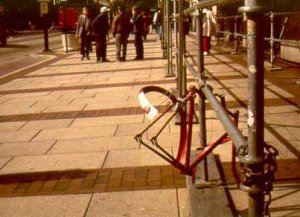 Providing
secure bicycle parking is a key ingredient in efforts to encourage bicycling
at the local level. Many bicycle journeys end somewhere other than the bicyclist's
home and, as a result, the bicyclist must park his or her bicycle. And for
those who live in apartment complexes, college dormitories, or other highdensity
settings, the issue of where to leave a bike while at home is also a serious
issue. In short, at one time or another, most bicyclists have experienced
the frustration of finding no secure place to leave their bikes.
Providing
secure bicycle parking is a key ingredient in efforts to encourage bicycling
at the local level. Many bicycle journeys end somewhere other than the bicyclist's
home and, as a result, the bicyclist must park his or her bicycle. And for
those who live in apartment complexes, college dormitories, or other highdensity
settings, the issue of where to leave a bike while at home is also a serious
issue. In short, at one time or another, most bicyclists have experienced
the frustration of finding no secure place to leave their bikes.
Some have experienced the even greater frustration of returning to find their
bicycles stolen. In fact, statistics compiled by the Federal Bureau of Investigation
show that between 1988 and 1992, an average of approximately 450,000 bicycles
were reported stolen each year. These figures are low, according to the Lock
Smart Campaign, which estimates that roughly twice as many are stolen, but
never reported. They suggest that, with an average cost of $380 per bike,
the financial loss to American bicyclists amounts to $450 million dollars
per year.
While providing secure bicycle parking is not the entire solution to the
problem of theft, it certainly can help and it can increase bicyclists' comfort
in leaving their bicycles unattended. As a result, many bicycle owners may
be encouraged to make bicycle trips that they might otherwise forego.
22.3 Solution Overview
Bicycle parking can be provided in a wide variety of settings using three
basic approaches: bicycle racks (open-air devices to which a bicycle is locked),
bicycle lockers (stand-alone enclosures designed to hold one bicycle per unit),
and bicycle lock-ups (site-built secure enclosures that hold one or more bicycles).
For short-term parking, bicycle racks work well. At sites that require long-term
parking for a variety of potential users, lockers are the devices of choice.
For long-term parking for a limited number of regular and trustworthy users,
bicycle lock-ups can solve the problem.
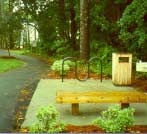
This trail provides many site amenities,
including short-term bike parking.
22.4 Objectives
- To provide well-located secure bicycle parking at popular destinations
in business districts and at other public sites:
- Install bicycle parking at public centers.
- Install bicycle parking on public rights of way in
neighborhood commercial and downtown business districts.
- Encourage private businesses to provide bicycle parking
for their customers.
- Install bicycle parking at transit stops and in parking
garages.
- Encourage the installation of high-security bicycle
parking at existing worksites, schools, and high-density residential
developments .
- To require new commercial, public, and high-density residential
developments to include plans for bicycle parking:
- Adding provisions to local zoning regulations requiring
bicycle parking as part of new developments, particularly commercial,
public, and high-density residential developments.
- Make these requirements part of the process of getting
a building permit.
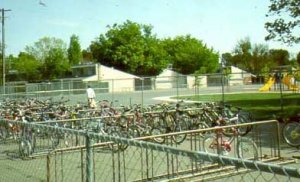
At community destination points such as schools,
ample bike parking should be provided.
22.5 Implementation Strategies
Implementing bicycle parking in a community requires a combination of three
primary strategies:
- Acquire and install bicycle parking devices on public rights of way or
at public destinations (e.g., city hall, libraries, and parks).
- Encourage businesses to provide bicycle parking for their customers.
- Alter zoning regulations to ensure that bicycle parking is provided in
new developments. Typically, the first strategy helps "prime the pump"
for the second; and the third strategy helps ensure longterm improvements
in newly developed areas.
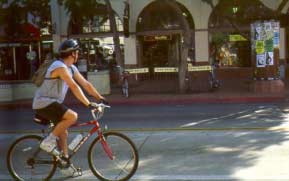
Encourage private businesses to provide bicycle parking for their customers.
22.6 Subtasks
- Identify key implementors.
Each of the three implementation strategies requires the cooperation of
a different group of constituencies. To put bicycle parking in public places
requires the cooperation of agencies who control the land involved. Sidewalks
may be controlled by the streets or public works department, while parks and
recreation may have responsibility for public open spaces and recreational
sites. There may be an agency (similar to the Federal Government's General
Services Administration) in charge of all public property. Or agencies that
run specific services (e.g., the library, public health clinics) may control
their own sites.
Encouraging businesses to install bicycle parking requires the cooperation
of such groups as the Chamber of Commerce, downtown business associations,
and shopping center managers. In addition, agencies that routinely deal with
businesses should be enlisted as outlets for any literature developed as part
of the program.
Altering zoning regulations to require consideration of bicycle parking in
new developments requires close cooperation with planning and zoning agency
staff, as well as the assistance from appointed zoning boards and builders'
associations. Typically, regulations are revised on a schedule; therefore,
the opportunity to revisit parking requirements may or may not be imminent.
- Structure the program.
In some communities, a reactive program that simply fills orders and
answers questions can prove to be successful. This would be most likely in
a "bicycle town" with a high degree of interest in bicycling matters.
However, in many places, such a passive approach would result in little response.
Business owners and managers of large employment centers or residential complexes
often see bicycles as clutter and a "problem" to be eliminated rather
than as a solution to traffic congestion or air quality problems. As a result,
a successful bicycle parking program should include elements of marketing
and promotion.
With the help of the key players identified in Subtask 1, create three ad
hoc task groups covering each of the three primary thrusts. The groups should
create the ground rules and materials necessary for the following tasks:
Task Group 1: Public Bicycle Parking
- Install bicycle parking at public centers.
- Install bicycle parking on public right of way.
- Install bicycle parking at transit stops and in parking garages.
Task Group 2: Private Bicycle Parking
- Encourage private businesses to provide bicycle parking for their customers.
- Encourage installation of high-security bicycle parking at worksites,
schools, and high-density residential developments.
Task Group 3: Zoning Regulation Revision
- Add provisions to local zoning regulations requiring bicycle parking.
- Make these requirements part of the process of getting a building permit.
- Choose appropriate bicycle parking devices.
As one of the first tasks, assemble packets of information on available bicycle
parking devices, along with the pros and cons of each device. In a joint meeting(s)
with all three task groups, adopt a set of criteria and decide which devices
are to be endorsed. A set of possible criteria are listed in the Specifications
section below. Next, give each task group its marching orders. They are as
follows:
New ordinances should address the following: (examples taken from existing
ordinances in Ann Arbor, MI; Madison, WI; Denver, CO; and San Francisco City/County,
CA):
- Bike parking ordinances should clearly indicate how many bicycle parking
spaces are required, either as a function of the type of development (retail,
office, residential, etc.) or as a standard percentage of the required
off-street automobile parking. For example, the City of Denver requires
that off-street automobile parking facilities of 20 spaces or more provide
bicycle parking equal to 5 percent of the automobile parking space requirement.
- Bicycle racks that support the bike by the wheel should not be permitted.
- Bicycle racks should be located at least as close to the building entrance
as the nearest nonhandicapped parking space. The requirements can also
address lighting of bicycle racks, requirements to retrofit existing public
buildings, and protection from the elements.
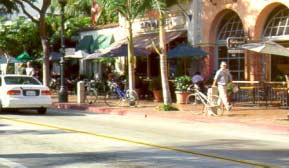
Zoning ordinances should include provisions for bicycle parking that
indicate how many spaces are required within specific districts.
- Tasks for Task Group 1: Public Bicycle Parking.
Task Group 1 should set criteria for installing bicycle parking devices
on sidewalks, as well as at public destinations. For sidewalks, criteria could
include such items as minimum width of sidewalk, rack position on sidewalk
and proximity to other street furniture and vegetation, and number per block
or number per site. For public sites, they could include proximity to the
main entrance, and minimum number of bicycle parking spaces per installation
(perhaps keyed to type of facility served).
Next, they should create an agreedupon step-by-step procedure for planning
and installation. This should include initial identification of the potential
site, discussion with relevant agency personnel, determination of the specific
site's needs (number of parking devices and location), cost analysis and budgeting,
procurement, installation, and follow-up.
To support this activity, they should create a project sheet for rack installation
that includes places for the source of the request (if any), signatures of
any required agency personnel, a schematic diagram of the site, installation
date, and any comments.
Next, they should estimate the total bicycle parking need for public places,
given a list of potential sites. Estimates can be conservative and based to
some extent on existing bicycle traffic, as long as participants realize that
latent demand may be significant.
For this reason, phased installation may be particularly appropriate. For
sidewalks, a base number of racks to be installed during the fiscal year (e.g.,
100, 500, 1000) should be decided upon, along with a map showing priority
areas. For instance, downtown might be a toppriority area, neighborhood commercial
areas could be second, and strip development areas might be third.
Finally, the Task Group should set an annual budget for the program and decide
how the bicycle parking should be paid for. Potential sources include a wide
variety of Federal transportation programs, as well as local funding opportunities.
- Tasks for Task Group 2: Private Bicycle Parking.
Task Group 2 should assemble a packet of information for potential private-sector
bike parking providers. The packet should include a cover letter describing
the importance of bicycle parking to businesses and giving any organizational
endorsements for the program; a list of available parking devices, along with
information on how to order them and which are best suited for which settings;
tips on deciding how many bikes need to be accommodated; and tips on locating
and installing the devices.
The Task Group should also work out details of any promotional activities
that will need to be planned. For instance, they should develop a list of
groups to talk with, determine who should be responsible for reaching each
one, and start making contacts. To this end, the Task Group should develop
a standard presentation, possibly including slides and handouts.
- Tasks for Task Group 3: Zoning Regulation Revision.
The Task Group should start by identifying passages in the existing zoning
codes where motor vehicle parking is discussed. They should find out when
the regulations are going to be modified and use that in determining their
schedule of work. They should next assemble sample bicycle parking laws from
other communities. Based on the sample laws, they should create a draft revision
to the regulations and circulate it for comment. Once comments have been received
and considered, they should forward a final draft revision for action at the
proper time.
Location Criteria
The location criteria are a mix of those developed by the Cities of Denver
and Seattle for placing bicycle racks:
- Racks should be located within 50 feet of building entrances (where
bicyclists would naturally transition into pedestrian mode).
- Racks should be installed in a public area within easy viewing distance
from the main pedestrian walkway, usually on a wide sidewalk with 5 or
more feet of clear sidewalk space remaining (a minimum of 24 inches of
clear space from the parallel wall, and 30 inches from the perpendicular
wall).
- Racks are placed to avoid conflicts with pedestrians. They are usually
installed near the curb and at a reasonable distance from building entrances
and crosswalks.
- Racks can be installed at bus stops or loading zones only if they do
not interfere with boarding or loading patterns and there are no alternative
sites.
-
Implement the program.
With the program set up, materials at the ready, and initial funding identified,
implementation of the program can begin. Routine responsibilities for the
various tasks should be taken care of by the agencies identified through the
previous steps. Oversight of the program may require the attention of a project
coordinator. This may be a task delegated to a member of the planning department
or public works staff.
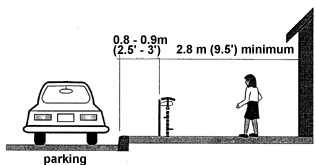
Philadelphia's standard for bike rack placement in business districts.
- Evaluate progress.
As the work is proceeding, keep track of successes and failures. Early on,
get the word out to the bicycling public that: (1) the program exists, and
(2) they should submit comments and ideas for potential parking sites. Keep
a record of how many parking devices have been installed, how many comments
have been received, how many information packets have been sent out, what
proportion of public places has adequate bicycle parking, how well the parking
is working (e.g., whether the public likes it, whether it holds up well to
vandalism), and how successful the zoning regulations appear to be (once they
are adopted). Use this feedback in fine-tuning the program and determining
future levels of funding.
22.7 Resource Requirements
For the most part, bicycle parking requires basic equipment: racks and lockers.
These can be ordered or fabricated in large or small quantities. Ordering
in quantity can save money as long as storage needs can be satisfied until
installation can be accomplished. Once a community gets actively involved
in bicycle parking installation, it is quite possible that local sources will
emerge. For instance, in some communities, welding shops make and sell approved
bike racks on a routine basis. This not only helps agencies satisfy a growing
bicycle parking demand, but it can lead to the development of new local industries.
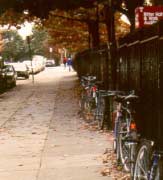
This is surely a location in need
of adequate bicycle parking.
22.8 Schedule
Installing bicycle parking at public places and on sidewalks can begin with
little delay. Encouraging businesses to install bicycle parking, being more
of a marketing and promotion activity, involves building interest over time
and may not pay off for several years. Even longer term are the results of
changes in zoning ordinances. At the same time, these changes can lead to
the greatest overall effect.
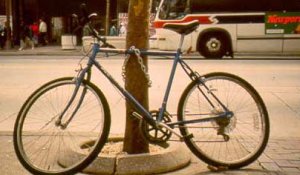
Street trees in Central Business Districts often become de facto bike racks.
22.9 Specifications
It is important to choose a bicycle rack design that is simple to operate.
Bicycle racks should be designed to allow the use of a variety of lock types.
It may be difficult initially to determine the number of bicycle parking spaces
needed: Bicycle racks should be situated onsite so that more racks can be
added if bicycle use increases. There are three general types of bicycle rack
designs. The following is information on each style (derived from the April
1996 issue of Pro Bike News).
Class I Bicycle Parking
This category includes bike lockers or locked/ guarded storage areas that
provide high-security protection.
Advantages:
High-security storage, ideal for longterm storage.
Disadvantages:
Expensive. Average cost per bike: Starter unit is $3,300, additional units
are $1,600 each.
Class II Bicycle Parking
This category includes racks that secure both wheels and bicycle frame, which
usually have moving parts and provide medium security with a user-supplied
lock.
Advantages:
Medium security, great when coupled with covered protection from the elements.
Disadvantages:
Moving parts, complex design, may not work with the common U-lock. Average
cost per bike: $65 to $150.
Class III Bicycle Parking
The most common type of Class III rack is the inverted "U" or rail
rack.
Advantages:
Simple design, affordable, can be manufactured by a local welder. Supports
frame as well as wheel.
Disadvantages:
Offers low level of security for long-term parking. Average cost per rack:
$75 installed (if purchased in quantities of 50 or more).
22.10 Sample Bike Parking Ordinance From Madison, Wisconsin
A growing number of communities have included bicycle parking requirements
in their development regulations. By so doing, they ensure that bicycle parking
is included in the normal course of development. This example is from the
Madison City Code.
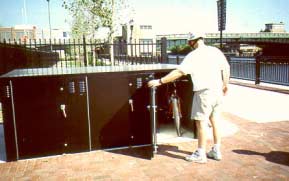
Bike lockers should be made available in areas where long-term parking
is necessary.
Purpose
To provide adequate and safe facilities for the storage of bicycles.
- Bicycle parking facilities shall be provided as required
for all new structures and uses established as provided in Sec. 28.11(2)(a)1
or for changes in use as provided in Secs. 28.11(2)(a)2 and 3; however,
bicycle parking facilities shall not be required until the effective date
of this paragraph. Notwithstanding Secs. 28.08(1)(i) and 28.09(5)(a), bicycle
parking facilities shall be provided in all districts, including districts
in the Central Area.
- In the residential district, accessory off-street parking
facilities provided for the uses listed herein shall be solely for the parking
of passenger automobiles and bicycles of patrons, occupants, or employees
and not more than one truck limited to a 1-ton capacity.
- Required bicycle parking spaces shall be at least 2 feet
by 6 feet. An access aisle of at least 5 feet shall be provided in each
bicycle parking facility. Such space shall have a vertical clearance of
at least 6 feet.
- Accessory off-street parking for bicycles shall include
provisions for secure storage of bicycles. Such facilities shall provide
lockable enclosed lockers or racks, or equivalent structures in or upon
which the bicycle may be locked by the user. Structures that require a usersupplied
locking device shall be designed to accommodate U-shaped locking devices.
All lockers and racks must be securely anchored to the ground or the building
structure to prevent the racks and lockers from being removed from the location.
The surfacing of such facilities shall be designed and maintained to be
mud- and dust-free.
- Bicycle parking facilities shall be located in a clearly
designated safe and convenient location. The design and location of such
a facility shall be harmonious with the surrounding environment. The facility
location shall be at least as convenient as the majority of automobile parking
spaces provided.
- Bicycle parking facility spaces shall be provided in
adequate number as determined by the Zoning Administrator. In making the
determination, the Zoning Administrator shall consider, when appropriate,
the number of dwelling units or lodging rooms, the number of students, the
number of employees, and the number of automobile parking spaces in accordance
with the following guidelines.
- In all cases where bicycle parking is required, no
fewer than two spaces shall be required.
- After the first 50 bicycle parking spaces are provided,
additional bicycle parking spaces required are 0.5 (one-half) space
per unit listed.
- Where the expected need for bicycle parking for a
particular use is uncertain due to unknown or unusual operating characteristics
of use, the Zoning Administrator may authorize that construction and
provision of not more than 50 percent of the bicycle parking spaces
be deferred. Land area required for provision of deferred bicycle parking
spaces shall be maintained in reserve.
Bicycle racks should be situated on site so that more racks can be
added if bicycle use increases.
22.11 References
Text and graphics for this section were derived from the following sources:
City of Philadelphia Bicycle Parking Specifications, 1998.
Institute of Transportation Engineers, Implementing Bicycle Improvements
at the Local Level, ITE LP- 471, Washington, DC, 1999.
Madison City Code, Madison, WI. Pro-Bike News, April 1996.
For more information on this topic, refer to:
Bicycle Federation of America, Source Book of Designs, Manufacturers,
and Representatives, 1992.
Bikecentennial, Technical Notes: Bike Parking Location; Choosing Parking
Devices; A Simple Bike Rack Design; Bike Parking Ordinances, 1987-89.
Ellen Fletcher, Bicycle Parking, 1990.
Off-Street Bicycle Parking Guidelines
| Land Use |
Bike Space |
| Dwellings/lodging rooms |
1 per dwelling unit or 3 lodging rooms |
| Clubs/lodges |
1 per lodging room plus 3% of person capacity |
| Fraternities/sororities |
1 per 3 rooms |
| Hotels/lodging houses |
1 per 20 employees |
| Galleries/museums/libraries |
1 per 10 automobile spaces |
| Colleges/universities/ junior high and high schools |
1 per 4 employees plus 1 per 4 students |
| Nursery/elementary schools |
1 per 10 employees, plus students above second grade |
| Convalescent and nursing homes/institutions |
1 per 20 employees |
| Hospitals |
1 per 20 employees |
| Places of assembly, recreation, entertainment, and amusement |
1 per 10 automobile spaces |
| Commercial/manufacturing |
1 per 10 automobile spaces |
| Miscellaneous/other |
To be determined by the Zoning Administrator based on the guide lines
for the most similar use listed above |
 Providing
secure bicycle parking is a key ingredient in efforts to encourage bicycling
at the local level. Many bicycle journeys end somewhere other than the bicyclist's
home and, as a result, the bicyclist must park his or her bicycle. And for
those who live in apartment complexes, college dormitories, or other highdensity
settings, the issue of where to leave a bike while at home is also a serious
issue. In short, at one time or another, most bicyclists have experienced
the frustration of finding no secure place to leave their bikes.
Providing
secure bicycle parking is a key ingredient in efforts to encourage bicycling
at the local level. Many bicycle journeys end somewhere other than the bicyclist's
home and, as a result, the bicyclist must park his or her bicycle. And for
those who live in apartment complexes, college dormitories, or other highdensity
settings, the issue of where to leave a bike while at home is also a serious
issue. In short, at one time or another, most bicyclists have experienced
the frustration of finding no secure place to leave their bikes. 







